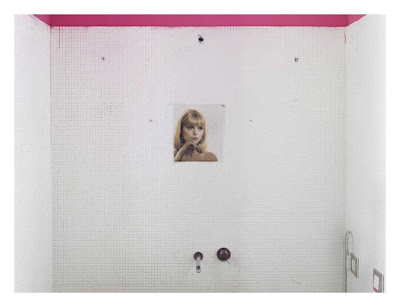La Belle Dame Sans Merci. By Alec Soth. Curated by Marco Delogu, with an essay by Francesco Zanot. Punctum Press, 2011. 52 pp., illustrated throughout, 12,5x15,25″. Edition of 500 (250 in Italian / 250 in English). Images from here.
I really like the work of Alec Soth and have previously featured this, this, this and this book with his work.
For 'La Belle Dame Sans Merci' Soth was commissioned by the 10th FotoGrafia Festival Internazionle di Roma and the result is a wonderful monograph inspired by the John Keats poem of the same name.
This book has already sold out in most places, but you can email photo-eye to get on a waiting-list for it.
Book description (source and source):
"A meditation on John Keats, Rome, pale men, beautiful women and pineapples by the photographer Alec Soth.
[...]
If John Keats often wrote poems in tribute to specific works and figures in more or less recent history Alec Soth follows a similar principle, setting the foundations of his own series on bases supplied by Keats.
The rooting of Soth’s LBDSM does not stop here, though, because he raises on the solid Keatsian platform a further level of quotations and many other references. Thus his still-life with a bowl and three pieces of fruit in the center harks back to Tony Harrison’s verses in A Kumquat for John Keats, and an apparently ordinary city scene is actually a partial reconstruction of a photo by Ruth Orkin, shot in Florence in 1951 and known by the title An American Girl in Italy; it shows a young woman besieged by leering men.
This is a veiled statement of the process that Soth uses to create his images, exploiting the possibilities of control and staging offered by what is known as 'staged photography' rather than (as he has done more often) merely recording the reality in front of his eyes, without altering it in any way.
This excessive adherence to the model leads to the suspension of images deprived of the quality that’s usually (and naively) attributed to any photo: truthfulness.
The result resembles awakening from a dream, exactly what happens in Keats’s La Belle Dame Sans Merci toward the end of the poem. What indubitably corresponded to reality until just a moment before turns out to be an imitation.
Keats died in Rome on February 23, 1821. Engraved on his tombstone in Rome’s non-Catholic cemetery is the famous epitaph 'Here lies one whose name was writ in water'.
Soth set his own LBDSM in Rome, suggesting a fanciful biographical reconstruction, and at the same time reconsidered the most typical ways of applying photography to a territorial-revision operation.
The project he developed takes account of his intention to depict the city of Rome, but updates the usual method of landscape research according to a logic whereby places are investigated in a context of further observations in the foreground. The city is part of the mystery that this work cannot fully unveil, but only capture in bits and snatches."



No comments:
Post a Comment